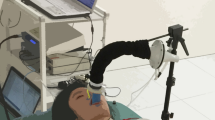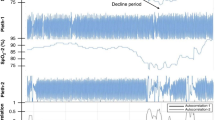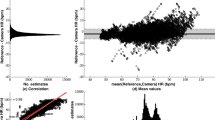Abstract
Objective
To assess the feasibility of using an ordinary digital video camera to measure heart rate and detect oxygen desaturations in healthy infants.
Study design
Heart rate and oxygen saturation were measured with a video camera by detecting small color changes in 28 infants’ foreheads and compared with standard pulse oximetry measures. Multivariable regression examined the relationship between infant characteristics and heart-rate measurement precision.
Results
The average bias of camera heart-rate measures was −4.2 beats per minute (BPM) and 95% limits of agreement were ±43.8 BPM. Desaturations detected by camera were 75% sensitive (15/20) and had a positive predictive value of 20% (15/74). Lower birth-weight was independently correlated with more precise heart-rate measures (8.05 BPM per kg, [95% CI 0.764–15.3]).
Conclusions
A digital video camera provides accurate but imprecise measures of infant heart rate and may provide a rough screening tool for oxygen desaturations.
This is a preview of subscription content, access via your institution
Access options
Subscribe to this journal
Receive 12 print issues and online access
$259.00 per year
only $21.58 per issue
Buy this article
- Purchase on SpringerLink
- Instant access to full article PDF
Prices may be subject to local taxes which are calculated during checkout



Similar content being viewed by others
Code availability
The computer code used is publicly available and may be freely downloaded from https://github.com/thearn/webcam-pulse-detector. The modified version used by the authors is available upon request.
References
Saugstad OD, Aune D. Optimal oxygenation of extremely low birth weight infants: a meta-analysis and systematic review of the oxygen saturation target studies. Neonatology. 2013;105:55–63.
Stenson BJ, Tarnow-Mordi WO, Darlow BA, Simes J, Juszczak E, Askie L, et al. Oxygen saturation and outcomes in preterm infants. N Engl J Med. 2013;368:2094–104.
Carlo WA, Finer NN, Walsh MC, Rich W, Gantz MG, Laptook AR, et al. Target ranges of oxygen saturation in extremely preterm infants. N Engl J Med. 2016;362:1959–69.
Murković I, Steinberg MD, Murković B. Sensors in neonatal monitoring: current practice and future trends. Technol Health Care. 2003;11:399–412.
Noonan C, Quigley S, Curley MAQ. Skin integrity in hospitalized infants and children. a prevalence survey. J Pediatr Nurs. 2006;21:445–53.
Shwayder Tor, Akland T. Neonatal skin barrier: structure, function, and disorders. Dermatol Ther. 2005;18:87–103.
Sun Y, Thakor N. Photoplethysmography revisited: from contact to noncontact, from point to imaging. IEEE Trans Biomed Eng. 2015;9294:1–1.
Mcduff DJ, Estepp JR, Piasecki AM, Blackford EB. A survey of remote optical photoplethysmographic imaging methods. Proc Annu Int Conf IEEE Eng Med Biol Soc EMBS. 2015;2015:6398–404.
Verkruysse W, Bartula M, Bresch E, Rocque M, Meftah M, Kirenko I. Calibration of contactless pulse oximetry. Anesth Analg. 2017;124:136–45.
Alexander CM, Teller LE, Gross JB. Principles of pulse oximetry: theoretical and practical consideration. Ansesthesia Analg. 1989;68:368–76.
Faisst K, Hannon W, Jørgensen JS, König V, Bucher HU, Huch A, et al. Reflectance pulse oximetry in neonates. Eur J Obstet Gynecol. 1995;61:117–22.
Cui W, Ostrander LE, Lee BY. In vivo reflectance of blood and tissue as a function of light wavelength. IEEE Trans Biomed Eng. 1990;37:632–9.
Mendelson Y, Ochs BD. Noninvasive pulse oximetry utilizing skin reflectance photoplethysmography. IEEE Trans Biomed Eng. 1988;35:798–805.
Tarassenko L, Villarroel M, Guazzi A, Jorge J, Clifton DA, Pugh C. Non-contact video-based vital sign monitoring using ambient light and auto-regressive models. Physiol Meas. 2014;35:807–31.
Poh M-Z, McDuff DJ, Picard RW. Non-contact, automated cardiac pulse measurements using video imaging and blind source separation. Opt Express. 2010;18:10762–74.
Verkruysse W, Svaasand LO, Nelson JS. Remote plethysmographic imaging using ambient light. Opt Express. 2008;16:21434–45.
Aarts LAM, Jeanne V, Cleary JP, Lieber C, Nelson JS, Bambang Oetomo S, et al. Non-contact heart rate monitoring utilizing camera photoplethysmography in the neonatal intensive care unit—a pilot study. Early Hum Dev. 2013;89:943–8.
Prahl S. Tabulated molar extinction coefficient for hemoglobin in water [Internet]. http://omlc.org/spectra/hemoglobin/summary.html.
Jiang J, Liu D, Gu J, Susstrunk S. What is the space of spectral sensitivity functions for digital color cameras? Proceedings of the IEEE Workshop on the Applications of Computer Vision. 2013;168–79.
Humphreys K, Ward T, Markham CA. CMOS camera-based pulse oximetry imaging system. Procedings of the Conference IEEE Engineering in Medicine and Biology Society. 2005;4:3494–7.
Kevat AC, Bullen DVR, Davis PG, Kamlin COF. A systematic review of novel technology for monitoring infant and newborn heart rate. Acta Paediatr Int J Paediatr. 2017;106:710–20.
Klaessens JH, van den Born M, van der Veen A, Sikkens-van de Kraats J, van den Dungen FA, Verdaasdonk RM. Development of a baby friendly non-contact method for measuring vital signs: first results of clinical measurements in an open incubator at a neonatal intensive care unit. Proc SPIE 8935, Adv Biomed Clin Diagnostic Syst Xii. 2014;8935:89351P.
Davis S, Watkinson P, Guazzi A, McCormick K, Tarassenko L, Jorge J, et al. Continuous non-contact vital sign monitoring in neonatal intensive care unit. Health Technol Lett. 2014;1:87–91.
Harford M, Catherall J, Gerry S, Young JD, Watkinson P. Availability and performance of image-based, non-contact methods of monitoring heart rate, blood pressure, respiratory rate, and oxygen saturation: A systematic review. Physiol Meas. 2019;40.
Webster JG. Design of pulse oximeters. Baton Rouge: Taylor & Francis Inc; 1997. p. 27.
Humphreys K, Ward T, Markham C. Noncontact simultaneous dual wavelength photoplethysmography: a further step toward noncontact pulse oximetry. Rev Sci Instrum. 2007;78:1–6.
Kong L, Zhao Y, Dong L, Jian Y, Jin X, Li B, et al. Non-contact detection of oxygen saturation based on visible light imaging device using ambient light. Opt Express. 2013;21:17464–71.
Hearn T. Webcam pulse detector [Internet]. https://github.com/thearn/webcam-pulse-detector.
Bland JM, Altman DG. Measuring agreement in method comparison studies. Stat Methods Med Res. 1999;8:135–60.
Bland J, Altman D. Agreement between methods of measurement with multiple observations per individual. J Pharm Stat 2007;17:571–82.
Oliveira V, Von Rosenberg W, Montaldo P, Adjei T, Mendoza J, Shivamurthappa V, et al. Early postnatal heart rate variability in healthy newborn infants. Front Physiol. 2019;10:1–12.
Fitzpatrick TB. The validity and practicality of sun-reactive skin types I through VI. Arch Dermatol. 1988;124:869–71.
D’Souza R, Raghuraman RP, Nathan P, Manyonda IT, Antonios TFT. Low birth weight infants do not have capillary rarefaction at birth: implications for early life influence on microcirculation. Hypertension. 2011;58:847–51.
Wieringa FP, Mastik F, Van Der Steen AFW. Contactless multiple wavelength photoplethysmographic imaging: A First Step Toward “SpO2 camera” Technology. Ann Biomed Eng. 2005;33:1034–41.
Corporation M. Radical-7 operator’s manual. Irvine, CA: Masimo Corporation; 2007.
Acknowledgements
We thank Marcia VanVleet, MD, James Padbury, MD, and the nurses working in the newborn nursery for their support. We thank the families of the infants who participated in this study, and the parents who granted us permission to publish the video of their infant. We thank Michael D. Goldberg, PhD and Joshua Bronson for helpful comments.
Author information
Authors and Affiliations
Contributions
MEW conceptualized and designed the study, designed the data collection instruments, collected data, performed data analyses, drafted the initial manuscript, reviewed and revised the manuscript. TGM designed the study, coordinated and supervised data collection, collected data, reviewed and revised the manuscript. MB critically reviewed and revised the manuscript. HM collected data and critically reviewed the manuscript. GJB designed the study, coordinated and supervised data collection, reviewed and revised the manuscript. All authors approved the final manuscript as submitted and agree to be accountable for all aspects of the work.
Corresponding author
Ethics declarations
Conflict of interest
The authors declare no competing interests.
Additional information
Publisher’s note Springer Nature remains neutral with regard to jurisdictional claims in published maps and institutional affiliations.
Supplementary information
Rights and permissions
About this article
Cite this article
Wieler, M.E., Murphy, T.G., Blecherman, M. et al. Infant heart-rate measurement and oxygen desaturation detection with a digital video camera using imaging photoplethysmography. J Perinatol 41, 1725–1731 (2021). https://doi.org/10.1038/s41372-021-00967-1
Received:
Revised:
Accepted:
Published:
Issue Date:
DOI: https://doi.org/10.1038/s41372-021-00967-1
This article is cited by
-
Enhancement of a Camera-Based Continuous Heart Rate Measurement Algorithm
SN Computer Science (2022)
-
Camera-based heart rate estimation for hospitalized newborns in the presence of motion artifacts
BioMedical Engineering OnLine (2021)



